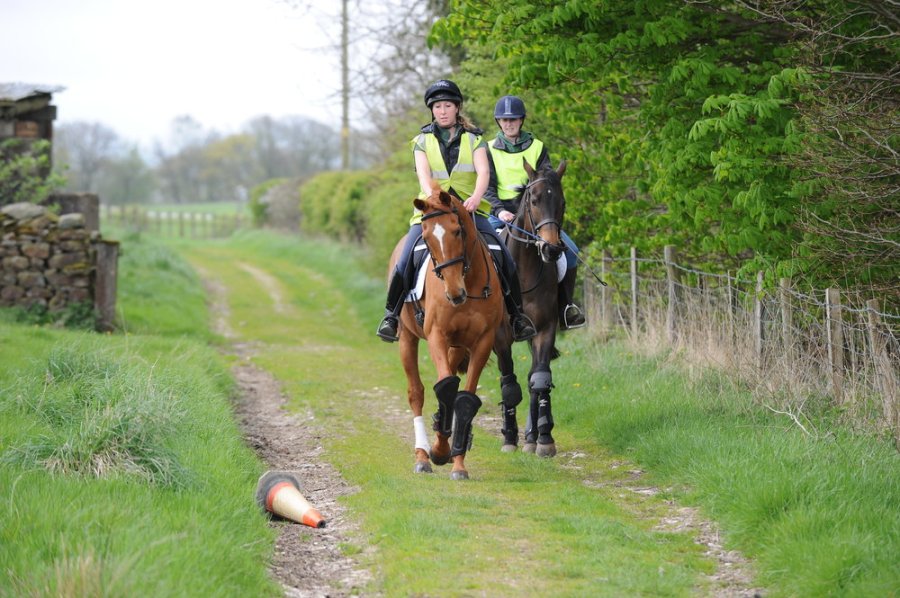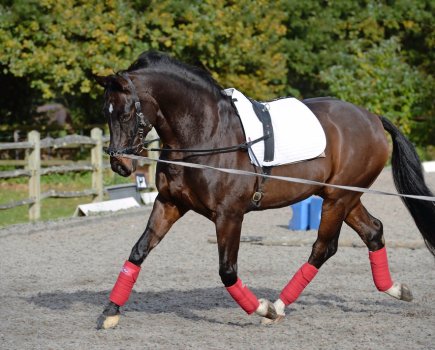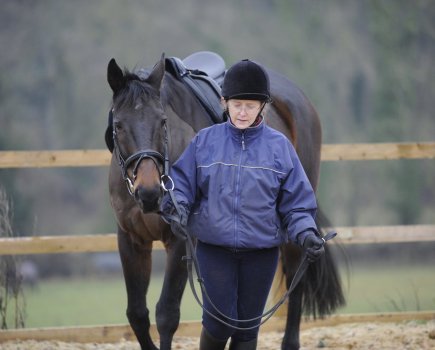Horses are flight animals and are designed to run away from trouble. It’s a survival thing — and completely natural horse behaviour.
However, running away isn’t (or shouldn’t be) an option for them when they’re being ridden, which causes them to feel trapped and become stressed. The behaviour a spooked horse exhibits is them saying, “I really can’t cope with this” when they hear, smell or see something that bothers them.
They may spin around, try to bolt or shy as a way of avoiding what they’re afraid of.
“Horses are only scared of two things — anything and everything,” says equine behaviourist Richard Maxwell. “When they’re stressed they go into what I call ‘up periscope’ mode. Their head is up, their tail is raised, and they are paying attention to everything except you.”
In very scared horses, ‘up periscope’ can be their default setting. Others show their stress through licking and chewing, so be vigilant to spot the signs. At first a spooked horse will say no when you ask them to change their behaviour.
Then it will probably get worse and they’ll say absolutely not. Only when they start to listen and understand will they finally agree.
Just keep in mind that you’ll need to be patient.
“I’m teaching the horse to be confident enough not to spook, or to stand still when they see something scary, then to take stock and move on,” explains Richard. This is acceptable to most riders, but running away isn’t.
Exercise 1: Move over to release tension
The aim of this exercise is to help your horse relax by introducing movement and asking them to move over.
“The main points of stress in your horse’s body are at the poll, the base of the neck and behind the saddle,” says Richard. “I want them to show me they’re relaxing by lowering their head.”
Richard advises that you avoid over-praising your horse at this point.
“I want them to realise that if they move across and drop their head a little, I will stop asking,” he explains. “Me telling them to do something is better than them reacting to instinct. We’re training them to cope.”
How to do it:
- Holding a lunge rein loosely with one hand and staying clear of any danger areas, ask your horse to move around you with their hindlegs crossing over.
- Initially ask using your hand or the rope, without touching. If they move over even just a bit, stop and let them think about it.
- The full-body lateral bend caused by your horse moving over relaxes the poll, and with repetition they’ll start to lower their head. It will take time so keep asking.
- If they’re not responding, try touching them gently with a schooling whip.
- By doing this work regularly, the horse will learn to wait for instructions instead of panicking, which can then be transferred to riding.
Exercise 2: Desensitise a spooked horse to noise
Richard introduces what he calls a ‘spook in a bottle’ — this is a rattling water bottle filled with rice or stones.
“This desensitises your horse to noise and you can also use it to startle them — to mimic a bird flying out of a bush for instance, which helps them cope when this actually happens. The bottle is only introduced when your horse is already relaxed from the ‘moving over’ technique in exercise 1,” states Richard.
“Your horse is thinking ‘this looks bad, smells bad and sounds bad, so it is bad’ and they’ll want to run away from the bottle.”
How to do it:
- Hold the lunge rein, but be prepared for your horse to move quickly away, and let them do this.
- Hold the bottle in your other hand. Approach your horse’s side and gently shake the bottle.
- Stay clear of their front legs in case they strike out.
- They will raise their head and move away, possibly quite dramatically, but keep going.
- Watch for the horse’s back legs crossing over — this is the lateral bend that helps them relax.
- Keep shaking the bottle until they stop moving; let them have a breather.
- When horses are stressed, they often hold their breath like humans. See if you can spot them taking a big breath, because it means they’re trying to de-stress a little.
- Repeat the exercise, stopping as soon as the horse stands still.
- With time, they’ll relax, breathe, their head will lower and they’ll be confident enough to stand while you shake the bottle near them.
- Success comes in small stages, and you won’t achieve everything in one session. Look for small improvements and do this exercise little and often.
Exercise 3: Add a little pressure
“Once your horse is happy with the bottle, take it up a notch and see if you can touch them with it,” advises Richard.
“You’ll probably go back to square one, with them over-reacting, but be consistent and, once they stand still, remove the bottle. Do this without shaking it at first as involving the noise will be too much.”
With time, a spooked horse will learn to lower their head and stand relaxed with the bottle touching them. You want them to be curious about the bottle and actively seek a closer look.
The horse may be brave enough to put their nose on it and have a sniff. When you feel your horse is ready, try touching them all over with the bottle, but always go back a step if necessary.
Exercise 4: Try a startle test
“Once they’ve got over the shock of the bottle, see if the horse will follow you on a loose line as you walk in front of them, shaking the bottle at the same time,” explains Richard. “They’ll like this as they’ll be fooled into thinking that if they follow it, it goes away.”
This is a good time to do a ‘startle’ test. Surprise the horse with it by quickly shaking it over one shoulder while you’re walking along. It could be a crisp packet or a scary bird flying by.
How does the horse react? The correct reaction is for your horse to stand still immediately. With more training, they’ll learn to keep walking when these things happen. This may take time of course, but as with everything else, repetition is key.
Richard Maxwell is an equine behaviourist who has combined conventional and natural training methods to develop his own style of practical horsemanship.
Main image: © Your Horse Library/Kelsey Media Ltd










